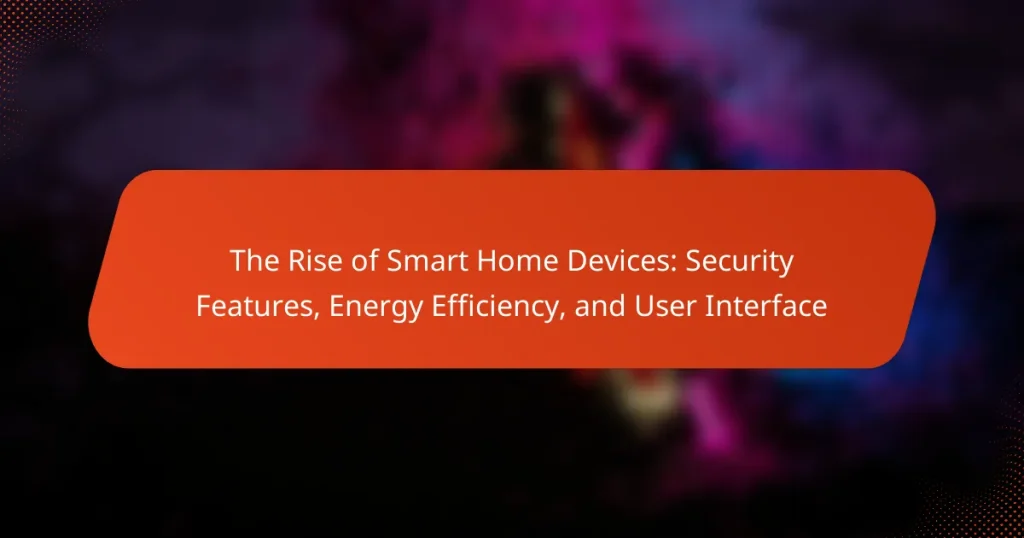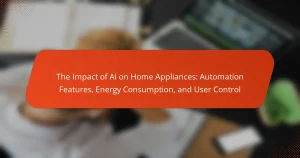Smart home devices are electronic tools that connect to a network, enabling remote control and enhancing home automation for improved user convenience. This article examines the rise of smart home devices, focusing on their security features, energy efficiency benefits, and user interface considerations. Key security elements include surveillance cameras, smart locks, and alarm systems that enhance safety through real-time alerts and data protection measures. Additionally, smart home technologies contribute to energy savings by optimizing consumption patterns, while user-friendly interfaces ensure accessibility and satisfaction. The global smart home market is projected to grow significantly, reflecting the increasing consumer demand for automation and efficiency.
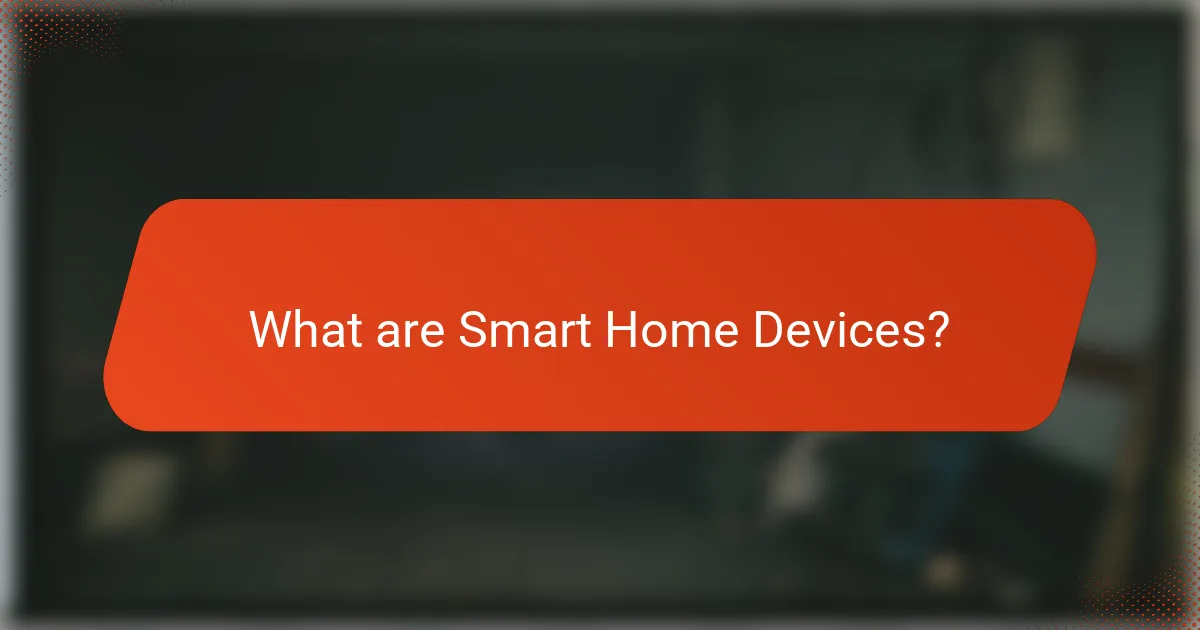
What are Smart Home Devices?
Smart home devices are electronic devices that connect to a network and can be controlled remotely. They enhance home automation and improve convenience for users. Examples include smart thermostats, smart lights, and security cameras. These devices often utilize Wi-Fi or Bluetooth technology for communication. According to a report by Statista, the global smart home market is projected to reach over $174 billion by 2025. This growth reflects increasing consumer interest in automation and energy efficiency.
How do Smart Home Devices enhance daily living?
Smart home devices enhance daily living by increasing convenience, security, and energy efficiency. They automate routine tasks, allowing users to control lighting, temperature, and appliances remotely. For instance, smart thermostats can adjust heating and cooling based on user preferences, reducing energy consumption by up to 15%. Security features include smart cameras and doorbells that provide real-time alerts and video feeds to homeowners. This enhances safety by allowing users to monitor their property from anywhere. Additionally, voice-controlled devices simplify interactions, making technology accessible to all family members. Overall, smart home devices significantly improve quality of life through automation and enhanced security.
What types of Smart Home Devices are commonly used?
Commonly used smart home devices include smart speakers, smart thermostats, smart lights, and smart security cameras. Smart speakers, like Amazon Echo or Google Nest, facilitate voice control and smart home integration. Smart thermostats, such as Nest or Ecobee, optimize energy use by learning user preferences. Smart lights, including Philips Hue or LIFX, offer remote control and automation features. Smart security cameras, like Ring or Arlo, enhance home security with real-time monitoring. These devices collectively improve convenience, energy efficiency, and security in modern homes.
How do Smart Home Devices integrate with existing home systems?
Smart home devices integrate with existing home systems through wireless communication protocols. These protocols include Wi-Fi, Zigbee, and Z-Wave. They allow devices to connect and communicate seamlessly with each other. For example, a smart thermostat can adjust the temperature based on data from smart sensors. Integration enhances automation and control of home functions. Many smart home ecosystems, like Google Home or Amazon Alexa, serve as central hubs. These hubs manage interactions between devices and user commands. Compatibility with existing systems is often achieved through standardized protocols. Research shows that over 70% of households are adopting smart home technology for improved efficiency and convenience.
What trends are driving the rise of Smart Home Devices?
Growing consumer demand for convenience and automation is driving the rise of smart home devices. Increased smartphone [censured] allows users to control devices remotely. Enhanced energy efficiency features attract environmentally conscious consumers. Security concerns also drive adoption, as smart devices offer advanced monitoring capabilities. Integration with voice assistants simplifies user interaction. The rise of the Internet of Things (IoT) facilitates device connectivity and interoperability. Additionally, competitive pricing and improved technology enhance accessibility for a broader audience. Market research indicates a projected growth rate of 25% annually in the smart home sector.
How has technology advancement contributed to the popularity of Smart Home Devices?
Technology advancement has significantly contributed to the popularity of smart home devices. Innovations in connectivity, such as Wi-Fi and Bluetooth, enable seamless integration of devices. The rise of the Internet of Things (IoT) allows for remote monitoring and control via smartphones. Enhanced user interfaces make devices more intuitive and user-friendly. Voice recognition technology has made interaction with devices simpler and more accessible. Data analytics improves device functionality and personalization for users. Additionally, advancements in security protocols have increased consumer trust in smart home systems. These factors collectively drive the growing adoption of smart home technology.
What consumer behaviors are influencing the adoption of Smart Home Devices?
Consumer behaviors influencing the adoption of Smart Home Devices include a growing demand for convenience and automation. Many consumers seek to simplify daily tasks through technology. Increased awareness of energy efficiency also drives adoption. Smart devices can help reduce energy consumption, appealing to environmentally conscious users. Security concerns play a significant role as well. Homeowners desire enhanced safety features, such as remote monitoring and alerts. Additionally, the influence of social proof is evident. Consumers are more likely to adopt these technologies when they see friends or family using them. Lastly, advancements in user interface design make smart devices more accessible and user-friendly. This ease of use encourages wider acceptance among various demographics.
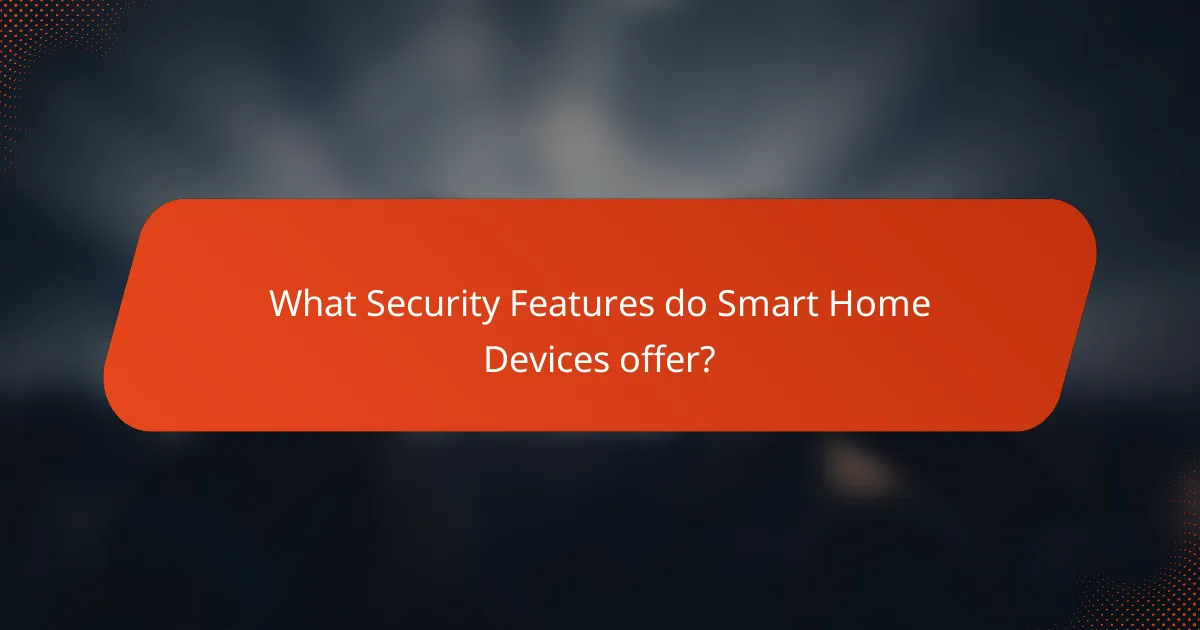
What Security Features do Smart Home Devices offer?
Smart home devices offer various security features to enhance home safety. These features include surveillance cameras that provide real-time video feeds. Many devices have motion detection capabilities to alert users of unusual activity. Smart locks allow for keyless entry and remote locking. Additionally, alarm systems can integrate with smart devices for immediate alerts. Encryption protocols protect data transmission from unauthorized access. Some devices offer two-factor authentication for added security. Regular software updates help patch vulnerabilities. Collectively, these features contribute to a more secure living environment.
How do Smart Home Devices ensure user privacy and data security?
Smart home devices ensure user privacy and data security through various measures. They utilize encryption protocols to protect data during transmission. Many devices implement two-factor authentication for user access. Regular software updates help patch security vulnerabilities. Some devices allow users to control data sharing preferences. Privacy policies outline how user data is collected and used. Manufacturers often adhere to industry standards and regulations. For instance, the General Data Protection Regulation (GDPR) sets strict guidelines for data protection. These measures collectively enhance user trust and safeguard sensitive information.
What encryption methods are used in Smart Home Devices?
Smart home devices commonly use encryption methods such as AES (Advanced Encryption Standard) and TLS (Transport Layer Security). AES provides strong symmetric encryption, ensuring data confidentiality. TLS, on the other hand, secures data transmitted over networks by encrypting the communication channel. Many devices also implement WPA2 (Wi-Fi Protected Access 2) for securing wireless networks. These encryption methods protect user data from unauthorized access and ensure secure communication between devices. Studies indicate that employing these methods significantly reduces the risk of cyber attacks on smart home systems.
How do manufacturers protect against hacking and unauthorized access?
Manufacturers protect against hacking and unauthorized access by implementing robust security measures. These measures include encryption, which secures data transmission between devices. They also utilize secure boot processes to ensure only authorized software runs on devices. Regular software updates are provided to patch vulnerabilities. Manufacturers often employ intrusion detection systems to monitor for suspicious activities. Multi-factor authentication adds an additional layer of security for user accounts. Security audits and compliance with industry standards further enhance protection. For instance, the National Institute of Standards and Technology (NIST) recommends specific guidelines for securing IoT devices. These practices collectively mitigate risks associated with unauthorized access.
What common security vulnerabilities exist in Smart Home Devices?
Common security vulnerabilities in smart home devices include weak passwords, unpatched software, and insecure network protocols. Many devices ship with default passwords that users often do not change. This makes them easy targets for unauthorized access. Additionally, manufacturers frequently release software updates to fix vulnerabilities. However, many users fail to install these updates, leaving their devices exposed. Insecure network protocols can also allow attackers to intercept data. For instance, devices that do not use encryption can transmit sensitive information openly. Furthermore, some smart home devices lack proper authentication mechanisms. This can enable unauthorized users to gain control over the devices. According to a 2021 report by Cybersecurity Insiders, 60% of organizations cite smart home devices as a significant security risk. These vulnerabilities highlight the need for better security practices among users and manufacturers.
How can users identify potential security risks?
Users can identify potential security risks by regularly updating device firmware and software. Keeping software current helps patch vulnerabilities. Users should also change default passwords to unique, strong passwords. This reduces the chance of unauthorized access. Monitoring network traffic can reveal unusual activity. Users can utilize security tools to scan for vulnerabilities. Reviewing device permissions ensures apps only access necessary data. Lastly, staying informed about security threats related to smart home devices is crucial. Regularly checking security blogs or forums can provide valuable insights.
What steps can be taken to mitigate these vulnerabilities?
Implementing strong password policies is crucial to mitigate vulnerabilities in smart home devices. Users should create complex passwords that combine letters, numbers, and symbols. Regularly updating these passwords enhances security. Enabling two-factor authentication adds an extra layer of protection. Keeping firmware and software updated is essential as manufacturers release security patches. Using a secure Wi-Fi network with encryption prevents unauthorized access. Disabling features like universal plug and play (UPnP) can reduce exposure to external threats. Regularly reviewing device settings and permissions ensures that only necessary access is granted. Monitoring device activity can help identify unusual behavior early. These steps collectively help secure smart home devices against potential vulnerabilities.

How do Smart Home Devices contribute to Energy Efficiency?
Smart home devices contribute to energy efficiency by optimizing energy consumption in households. These devices include smart thermostats, smart lighting, and energy monitoring systems. Smart thermostats adjust heating and cooling based on user behavior and environmental conditions. This can lead to energy savings of up to 10-15% annually. Smart lighting systems allow users to control lights remotely and set schedules, reducing unnecessary usage. Energy monitoring systems provide real-time data on energy consumption, enabling users to identify and eliminate wasteful practices. According to a study by the American Council for an Energy-Efficient Economy, smart home technologies can reduce energy use by 20-30%.
What are the energy-saving features of Smart Home Devices?
Smart home devices have several energy-saving features. These devices often include smart thermostats that optimize heating and cooling based on user habits. They can learn preferences and adjust settings automatically. Smart lighting systems use LED technology and can be controlled remotely to reduce energy waste. Many devices offer energy monitoring, allowing users to track consumption in real time. Smart plugs can schedule or turn off devices when not in use. Additionally, some smart appliances operate during off-peak hours to save on energy costs. These features can lead to significant reductions in energy consumption and costs.
How do Smart Home Devices optimize energy consumption?
Smart home devices optimize energy consumption by automating and controlling household energy use. They utilize sensors and algorithms to monitor energy usage patterns. Devices like smart thermostats adjust heating and cooling based on occupancy. Smart lighting systems can dim or turn off lights when no one is present. Energy monitoring plugs track the consumption of individual appliances. These devices can be programmed to operate during off-peak energy hours, reducing costs. According to the U.S. Department of Energy, smart thermostats can save up to 10-15% on heating and cooling bills. Overall, smart home devices contribute to more efficient energy management in households.
What impact do Smart Home Devices have on overall household energy bills?
Smart home devices can significantly reduce overall household energy bills. These devices optimize energy consumption by automating and controlling appliances. For example, smart thermostats can adjust heating and cooling based on occupancy, leading to energy savings. A study by the American Council for an Energy-Efficient Economy found that smart thermostats can save users up to 10-15% on heating and cooling costs annually. Additionally, smart plugs and lighting systems allow users to monitor and manage energy use more effectively. This increased efficiency contributes to lower utility bills over time.
What role do Smart Home Devices play in sustainable living?
Smart home devices significantly contribute to sustainable living by enhancing energy efficiency. These devices optimize energy consumption through automation and real-time monitoring. For example, smart thermostats adjust heating and cooling based on occupancy, reducing unnecessary energy use. Smart lighting systems can be programmed to turn off when not needed, further minimizing energy waste. According to a study by the American Council for an Energy-Efficient Economy, homes with smart devices can save up to 30% on energy bills. This reduction in energy usage directly translates to lower carbon emissions. Additionally, smart appliances can operate during off-peak hours, aligning energy use with renewable energy availability. Overall, smart home devices facilitate a more sustainable lifestyle by promoting efficient resource management.
How can Smart Home Devices support renewable energy sources?
Smart home devices can support renewable energy sources by optimizing energy consumption and integrating with solar and wind systems. These devices can monitor energy usage in real-time. They can adjust settings to reduce consumption during peak hours. For example, smart thermostats can learn user habits to minimize heating and cooling when renewable energy is low. Additionally, smart plugs can schedule appliances to run when renewable energy production is high. Research shows that homes equipped with smart devices can reduce energy costs by up to 30%. This demonstrates the potential of smart home technology to enhance the efficiency of renewable energy use.
What are the environmental benefits of using Smart Home Devices?
Smart home devices offer significant environmental benefits by enhancing energy efficiency. These devices optimize energy consumption by automatically adjusting heating, cooling, and lighting based on usage patterns. For example, smart thermostats can reduce energy usage by up to 10-15% annually. This reduction leads to lower greenhouse gas emissions from power plants.
Additionally, smart home devices can manage appliances to operate during off-peak hours. This strategy helps to balance energy demand and reduce strain on the electrical grid. Energy-efficient smart devices often have Energy Star ratings, indicating they use less energy than standard models.
Furthermore, smart irrigation systems can conserve water by delivering precise amounts only when needed. Studies show that these systems can reduce water usage by up to 50%. Overall, the adoption of smart home devices contributes to a more sustainable living environment by reducing waste and conserving resources.
How can users maximize the energy efficiency of their Smart Home Devices?
Users can maximize the energy efficiency of their smart home devices by optimizing settings and usage patterns. Scheduling devices to operate during off-peak hours reduces energy costs. Utilizing energy-saving modes can significantly lower consumption. Regularly updating device software ensures access to the latest efficiency features. Integrating devices with a smart home hub allows for better management and automation. Monitoring energy usage through apps helps identify high-consumption devices. Choosing Energy Star-rated products guarantees better efficiency. These strategies collectively contribute to reduced energy waste and lower utility bills.
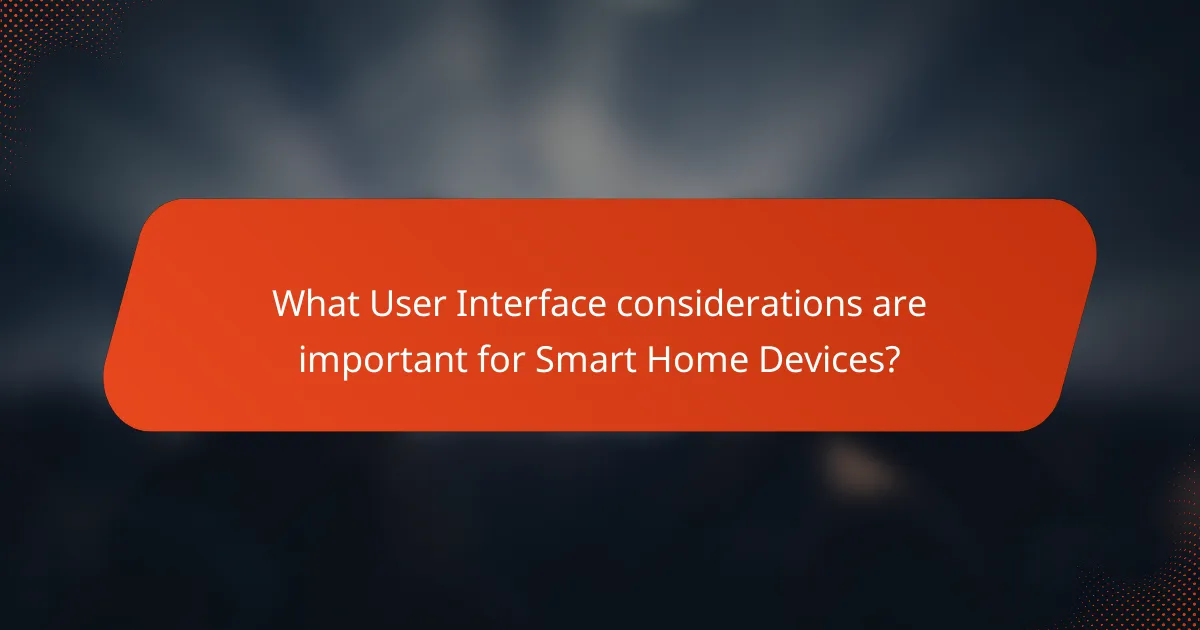
What User Interface considerations are important for Smart Home Devices?
User Interface considerations for Smart Home Devices include simplicity, usability, and accessibility. The interface should be intuitive, allowing users to operate devices without confusion. Clear visual feedback is essential to confirm user actions. Customization options enhance user satisfaction by accommodating individual preferences. Voice control integration improves accessibility for users with mobility challenges. Compatibility with multiple platforms ensures seamless interaction across devices. Security features must be evident to build user trust. Regular updates to the interface can enhance functionality and user experience. Research indicates that user-friendly interfaces significantly increase device adoption rates.
How does user interface design affect the usability of Smart Home Devices?
User interface design significantly impacts the usability of smart home devices. A well-designed interface enhances user interaction and satisfaction. It allows users to navigate features easily and access functionalities quickly. Clear visual elements and intuitive layouts reduce the learning curve for new users. For instance, a study by the Nielsen Norman Group found that users prefer interfaces that are simple and easy to understand. This leads to fewer errors and increased efficiency in device operation. Additionally, responsive design ensures that users can control devices seamlessly across different platforms. Overall, effective user interface design is crucial for maximizing the usability of smart home devices.
What are the key elements of an effective user interface for Smart Home Devices?
The key elements of an effective user interface for smart home devices include simplicity, intuitiveness, responsiveness, and accessibility. Simplicity ensures that users can easily navigate the interface without confusion. Intuitiveness allows users to understand functionality without extensive instruction. Responsiveness refers to the interface’s ability to react quickly to user inputs, enhancing user experience. Accessibility ensures that all users, including those with disabilities, can interact with the device. These elements contribute to a seamless user experience, promoting consistent usage and satisfaction. Research indicates that user interfaces designed with these principles lead to higher user engagement and lower frustration rates.
How do user interfaces differ across various Smart Home Devices?
User interfaces across various smart home devices differ significantly in design, functionality, and user experience. Smart speakers typically use voice commands as their primary interface, allowing hands-free operation. In contrast, smart thermostats often feature touchscreen displays for direct interaction and visual feedback. Smart security cameras usually offer mobile app interfaces that provide live feeds and notifications. Smart lighting systems may use both mobile apps and physical switches for control. Each device type is tailored to its specific function, enhancing user convenience. The diversity in interfaces reflects the unique user needs and contexts for each device. For instance, a smart lock may emphasize security features in its interface, while a smart refrigerator could focus on inventory management. This variation ensures that users can efficiently interact with devices according to their intended purposes.
What challenges do users face with Smart Home Device interfaces?
Users face several challenges with Smart Home Device interfaces. Common issues include complexity in setup and navigation. Many interfaces have steep learning curves. Users often struggle with inconsistent app designs. Compatibility issues between devices can lead to frustration. Voice recognition errors can hinder user experience. Security concerns about data privacy are prevalent. Limited customization options may not meet user needs. Lastly, inadequate customer support can exacerbate these challenges.
How can manufacturers improve user experience in Smart Home Devices?
Manufacturers can improve user experience in Smart Home Devices by focusing on intuitive interfaces and seamless integration. User-friendly designs enhance accessibility for all age groups. Incorporating voice control features simplifies operation. Regular software updates ensure devices remain secure and functional. Providing comprehensive customer support builds trust and aids troubleshooting. Offering customization options allows users to tailor settings to their preferences. Research indicates that 70% of users prioritize ease of use in smart devices. This focus on user experience can lead to higher customer satisfaction and retention.
What resources are available for users to learn about Smart Home Device interfaces?
Users can learn about Smart Home Device interfaces through various resources. Online platforms such as YouTube offer tutorials and demonstrations. Websites like CNET and TechRadar provide in-depth reviews and guides. Manufacturer websites often have user manuals and FAQs. Community forums, such as Reddit, allow users to share experiences and tips. Additionally, blogs focused on home automation cover trends and insights. Online courses on platforms like Udemy teach specific skills related to smart home technology. These resources collectively enhance user understanding of smart home interfaces.
What best practices can users follow to navigate Smart Home Device interfaces effectively?
Users can navigate Smart Home Device interfaces effectively by following specific best practices. First, familiarize yourself with the device’s user manual or online resources. This helps in understanding features and functionalities. Second, utilize voice commands if supported, as they simplify interaction. Third, organize devices into groups within the app for easier management. Fourth, regularly update the device software to ensure optimal performance and security. Additionally, customize settings to suit personal preferences, enhancing usability. Finally, practice patience and explore all features, as familiarity will improve navigation over time. These practices enhance user experience and efficiency with Smart Home Devices.
Smart home devices are electronic tools that enhance home automation by connecting to networks for remote control, improving convenience, security, and energy efficiency. This article covers the various types of smart home devices, their integration with existing systems, and the trends driving their adoption. Key features discussed include security capabilities, user privacy measures, energy-saving attributes, and the significance of user interface design in enhancing usability. Additionally, the article addresses common vulnerabilities and best practices for users to maximize the effectiveness of their smart home technologies.
